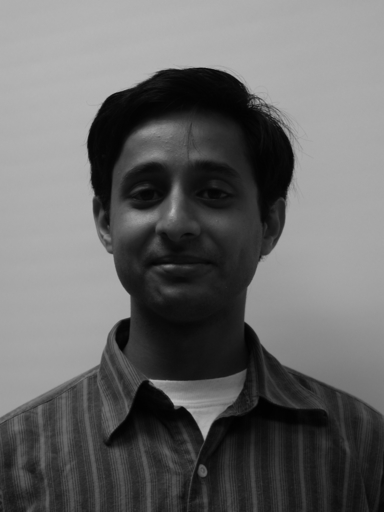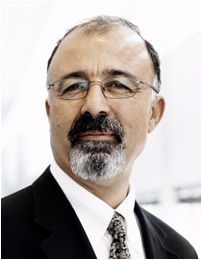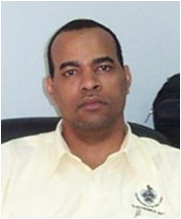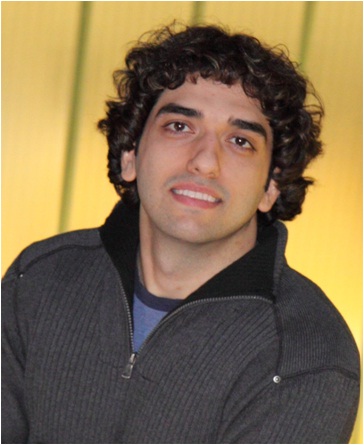|
|

Dr. Shouri Chatterjee
Indian Institute of Technology, Delhi
Date: May 19th, 2:00pm
Location: CEPSR 414
|
Energy scavenging from ambient RF - challenges and responses
Abstract:
In this talk we will touch upon the three important building blocks of an RF energy harvesting circuit - the antenna,
the matching network, and the rectifier. A 377 ohm antenna could be optimal for maximum power transfer between the atmosphere
and the antenna. However, a choice for impedance levels in the subsequent circuits would depend on the scavenging circuit architecture.
A matching network is used to transfer maximum power from a source (the antenna) to a load (the charging circuit.)
Traditional matching networks match an arbitrary load to an arbitrary source at a single frequency. This talk will develop techniques
to match an arbitrary source to an arbitrary load at multiple frequencies. A multiband matching network, designed to match the source
to the load at properly chosen frequencies, will significantly increase the scavenged power available to the charging circuit.
Energy scavenging circuits typically use a variety of charge pumps. In this talk we will discuss Dickson and Cockroft charge pumps as
charging circuits. Techniques based on DC-DC boost converters will be introduced. A solution to reduce shoot through power losses, and
to reduce constraints on the precision of the clocking in boost converters will be proposed, with preliminary laboratory results.
Biography:
Shouri Chatterjee received the B.Tech. degree in Electrical Engineering from the Indian Institute of Technology, Madras, in 2000,
and the M.S. and Ph.D. degrees in Electrical Engineering from Columbia University, New York, in 2002 and 2005, respectively.
From 2005 to 2006, he was a design engineer in the wireless division at Silicon Laboratories Inc., Somerset, NJ. Since 2006 he has
been with the faculty of the department of Electrical Engineering of the Indian Institute of Technology, Delhi, India. Dr. Chatterjee's
research interests are in ultra-low-power and ultra-low-voltage circuits, circuits for on-chip instrumentation, and filter design.
|
|

Dr. Mohamad Sawan
Polytechnique Montreal
Date: May 6th, 3:00pm
Location: Interschool Lab CESPR
|
Brain-Machine Interfaces for Intracortical Biosensing and Treatment of Central Neural System Dysfunctions
Abstract:
Emerging brain-machine interfaces dedicated for biosensing and treatment applications are promising alternative for learning about the
intracortical organization, studying the neural activity underlying cognitive functions and pathologies, locating onset seizures,
understanding neurons interactions, detecting mind-driven decisions, address complex central neural system dysfunctions by both
microelectrostimulation and drug delivery Microsystems. This talk covers circuits and systems techniques used for the design and
integration of biosensing and treatment microsystems. Such devices are fully implantable, interconnected to intracortical neural tissues,
and include wireless links used to power up such implanted devices and bidirectionally exchange data with external base station. Global
view of typical devices altogether with corresponding multidimensional challenges such as power management and high-data rate communication
modules will be described. Special attention will be paid to present digital and analog circuit techniques dedicated to parallel detecting
and recording of action potentials and seizures through large arrays of electrodes. In addition, microstimulation in the primary visual
cortex, which is intended to recover vision for the blind through multisite large arrays of electrodes, will be summarized as case study
of the intended treatments.
Biography:
Mohamad Sawan received the Ph.D. degree in 1990 in electrical engineering, from Sherbrooke University, Canada. He joined Polytechnique
Montreal in 1991, where he is currently a Professor of Microelectronics and Biomedical Engineering. His scientific interests are the
design and test of mixed-signal (analog, digital, RF, MEMS and optic) circuits and Microsystems: design, integration, assembly and
validations. These topics are oriented toward the biomedical and telecommunications applications. Dr. Sawan is a holder of a Canada
Research Chair in Smart Medical Devices. He is founder director of the Polystim Neurotechnologies Laboratory at Polytechnique Montreal,
and he is leading the Microsystems Strategic Alliance of Quebec (ReSMiQ) receiving membership support from 11 Universities.He is founder
/ co-founder of several International conferences such as NEWCAS, BiOCAS, and ICECS, and he is Editor/ Associate Editor of several
International Journals such as the IEEE Transactions on Biomedical Circuits and Systems and the Springer Mixed-signal Letters. Dr. Sawan
published more than 450 papers in peer reviewed journals and conference proceedings, offered more than 100 invited talks/keynotes, and he
was awarded 6 patents pertaining to the field of biomedical sensors and actuators.Dr. Sawan received several prestigious awards; the most
important of them are the Medal of Honor from the President of Lebanon, the Bombardier Award for technology transfer, the Barbara Turnbull
Award for medical research in Canada, and the achievement Award from the American University of Science and Technology. Dr. Sawan is Fellow
of the IEEE, Fellow of the Canadian Academy of Engineering, Fellow of the Engineering Institute of Canada, and Officer of the Quebec's
National Order.
|
|

Dr. Paul Aiken
The University of the West Indies at Mona, Jamaica
Date: April 25th, 2:00pm
Location: CESPR 414
|
Signal and Power Integrity in High Speed Digital Circuits
Abstract:
The continuous trend in designing digital circuits and systems for faster speeds has created many new problems for designers. One such problem is the ability to reliably transmit and receive high speed digital data between the various components on a computer mother board. At these high data rates, the signal pathways are transformed into complex transmission lines with many impedance discontinuities that create many levels of signal distortions and attenuation. The increased switching rates of the microprocessor create an increase demand for instantaneous current from the computer power supply, which is usually connected to the mother board through long cables. The power path forms a complex transmission line to these instantaneous current demands, resulting in large voltage droops. This talk will provide an overview of the various signal and power integrity challenges and some techniques that may be used to overcome them. The requirements for performing signal and power integrity analysis along with good design practices and the importance of adequate measurement tools and capabilities will also be highlighted. Finally, some case studies of actual measurements done on Intel motherboards and testers will be showcased.
Biography:
Paul Aiken graduated from FuSEAS, Columbia University in 2004 with a PhD in Electrical Engineering. For the next 2+ years he worked at Intel as a Senior Test Engineer with responsibilities of leading teams to design devices for high volume testing of Microprocessors, RF pathfinding and Signal Integrity. During this time he lead technical teams in developing practical solutions to overcome signal integrity issues that were limiting data rates on motherboards. His contribution assisted in increasing the front side bus (FSB) speed from 800 MBs to 15 GBs. Paul returned to The University of the West Indies in Jamaica to offer his services in developing science and technology across secondary and tertiary schools and within local industries. He currently teaches courses in electronics engineering and physics and performs research in RF circuits design, novel instruments, and electrical characterization of dye sensitized solar cells. Paul also served as an adjunct associate professor of engineering at the University of Technology in Jamaica and was recently elevated to a senior member of the IEEE.
|
|

Dr. Shahriar Shahramian
Member of Technical Staff, Alcatel-Lucent Inc.
Date: April 22nd, 2:00pm
Location: CESPR 414
|
Mm-Wave Silicon Circuits for Mixed-Signal Applications
Abstract:
The number of reported millimeter-wave and sub-millimeter wave integrated circuits has grown significantly in the recent years. With the ever-increasing performance of Silicon based technologies, many mixed-signal circuits such as data converters and phase-locked loops have found their way into the millimeter-wave realm. In this talk the design methodology, layout techniques and architectural challenges of several millimeter-wave mixed-signal circuits are explored. In particular, the implementation strategy of a 4-bit, 35-GS/s Flash ADC-DAC chain in a SiGe BiCMOS technology is presented. Furthermore, the CMOS realization of a few fundamental ADC building blocks including a 30-GS/s track-and-hold amplifier and an 81-Gb/s retimer is discussed. Finally, the design considerations and performance of the highest frequency phase-locked-loop operating in the W- and D-band is presented.
Biography:
Shahriar Shahramian received his Ph.D. degree from University of Toronto in 2010 where he focused on the design of SiGe and CMOS mm-wave data converters. Shahriar received the Aloha Award in recognition of his B.A.Sc. thesis. He was also the recipient of the Ontario Graduate Scholarship in 2003 and University of Toronto Fellowship from 2004-2006. He was awarded the best paper award at the Compound Semiconductor IC Symposium in 2005. Shahriar also holds six consecutive teaching awards at University of Toronto. He is currently a Member of Technical Staff (MTS) at the Bell Labs division of Alcatel-Lucent, Murray Hill, NJ. His research interests include the design of the next generation wireless and wireline circuits and systems.
|
|
|
|

